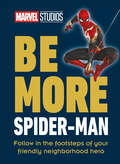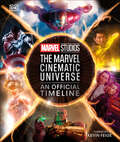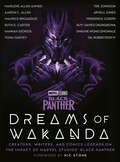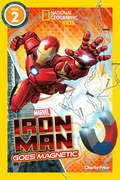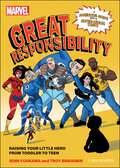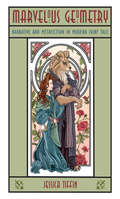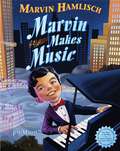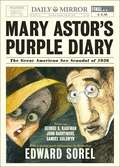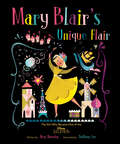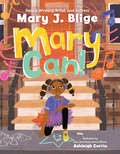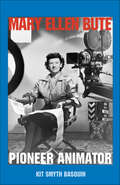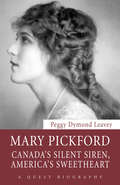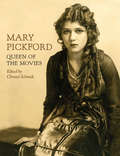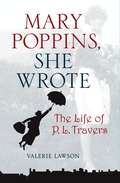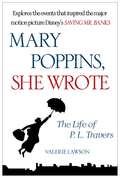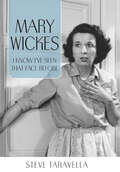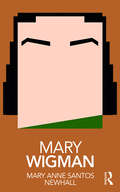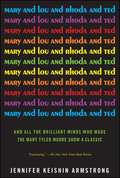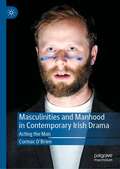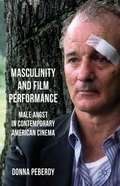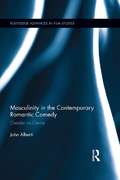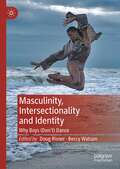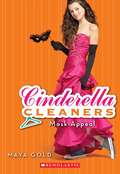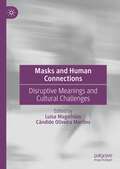- Table View
- List View
Marvel Studios Be More Spider-Man: Follow in the Footsteps of Your Friendly Neighborhood Hero (Be More)
by Kelly KnoxSpider-Man is the most relatable hero in the MCU—he&’s the hero who could be you!Be inspired by Spider-Man, the neighborhood hero who balances his great powers with great responsibility. This web-swinging Avenger will stop at nothing to save those in need and is hugely loyal to friends and family. In the pages of this book, learn to think on your feet and, like Spider-Man, always have a witty comeback at the ready, even when backed into a corner Packed with iconic movie scenes, inspiring quotes, and handy lifestyle tips from Marvel Studios&’ blockbuster movies, such as 2019&’s Spider-Man: Far From Home and 2021&’s Spider-Man: No Way Home, Be More Spider-Man is the ideal gift for your family, friends, colleagues – in fact, your whole neighborhood! © 2022 MARVEL © 2022 CPII.
Marvel Studios The Marvel Cinematic Universe An Official Timeline
by Anthony Breznican Amy Ratcliffe Rebecca Theodore-VachonBecome a master of the Marvel Cinematic Universe!The Marvel Cinematic Universe (MCU) is vast, incredibly varied, and richly complex. Different worlds, different timelines, countless characters. This is the guide to that universe. Created in close collaboration with Marvel Studios, it will answer the biggest questions: what happened, when, and where.Follow the entire story of the MCU from before the Big Bang to the Blip and beyond. Along the way, learn more about the evolution of the Iron Man armors, the hunt for the Infinity Stones, and the formation of the Multiverse. Want to know how many times aliens have invaded Earth, or the complete history of Cap&’s shield? Look no further!A treasured keepsake for any movie buff, filled with exclusive infographics, illuminating timelines, and amazing movie stills, this book will have pride of place on any MCU fan&’s shelf.© 2023 MARVEL
Marvel Studios' Black Panther: Creators, Writers, and Comics Legends on the Impact of Marvel Studios' Black Panther
by Maurice Broaddus Marvel Frederick Joseph Suyi Davies Okungbowa Yona Harvey Ruth E. Carter Hannah Giorgis Tre Johnson Marlene Allen Ahmed Aaron C. Allen Arvell Jones Dwayne Wong Omowale Gil Robertson Mateus ManhaniniJoin creators, writers, and comics legends as they discuss the impact of Marvel Studios&’ Black Panther in this gorgeously illustrated collection of essays Marvel Studios&’ Black Panther has become more than just a movie—it has shaped conversations about art, culture, science fiction, representation, justice, fashion, comics, creativity, and so much more. Celebrate the legacy of the film with this collection of all-new personal essays and reflections that shed light on its monumental impact, including firsthand stories from artists involved in the film, cultural analysis from journalists and academics, and thoughtful insights from writers and comics legends. Each contributor brings their unique expertise and experience to explore the film&’s genesis and significance from every angle. Complete with gorgeous original illustrations, Dreams of Wakanda brings together a wide array of diverse and multifaceted perspectives that exemplify the many ways the film has impacted cinema, culture, and society. In this collection:• Costume designer Ruth E. Carter takes us through her Afrofuturistic designs.• Writer Tre Johnson discusses the metaphoric qualities of vibranium.• Author Yona Harvey reflects on how the film has resonated with audiences across the African diaspora.• Journalist Hannah Giorgis uncovers how the soundtrack fits into sonic portraits of Blackness. The contributors:Marlene Allen Ahmed • Aaron C. Allen • Maurice Broaddus • Ruth E. Carter • Hannah Giorgis • Yona Harvey • Tre Johnson • Arvell Jones • Frederick Joseph • Suyi Davies Okungbowa • Dwayne Wong Omowale • Gil Robertson IV • Foreword by Nic Stone • Art by Mateus Manhanini To celebrate the launch of this book and Black Panther&’s global impact, Disney and Penguin Random House are donating books to First Book and Books for Africa respectively. Disney is donating books valued at approximately $1,000,000 to support First Book, a leading nonprofit that serves children in underserved communities and addresses the needs of the whole child by supporting their education, basic needs, and wellness—all of which are essential to educational equity. Penguin Random House (PRH) is donating PRH titles valued at approximately $100,000 to Books For Africa. Books For Africa was founded upon a singular mission: to end the book famine in Africa. BFA collects, sorts, and ships books, computers, tablets, and library enhancement materials to every country in Africa.
Marvel's Iron Man Goes Magnetic (National Geographic Readers)
by National Geographic KidsNational Geographic Kids and Marvel combine forces on this leveled reader series featuring magnets and kids&’ all-time favorite super hero, Iron Man.It&’s time to assemble some magnets—Avenger style!Join Iron Man in his lab as he marvels at the mystery of his favorite suit going … magnetic! Discover what makes some metals magnetic and how they work. With engaging photographs, iconic illustrated Marvel Comics character guides, and hilarious commentary by beloved Avengers friends, this book is perfect for newly independent and reluctant readers. Take learning to a new level through fun facts and a step-by-step hands-on experiment to reinforce educational concepts.This level 2 reader provides both accessible and wide-ranging text to encourage the scientists and inventors of tomorrow!
Marvel: Raising Your Little Hero from Toddler to Teen
by Jenn Fujikawa Troy BenjaminWith great power, there must also come great responsibility—and there&’s no one more powerful than a parent, in the Marvel Universe or our own. Great Responsibility: Raising Your Little Hero from Toddler to Teen is the perfect guide for the Marvel fan on the greatest Journey into Mystery of all: parenthood. Whether it's the struggles of raising a God of Thunder and a God of Mischief concurrently, or dealing with your angsty teen's mutant tendencies, parents can learn a lot from our favorite characters' journeys. Let&’s face it, turning your kids into well-rounded humans who aren&’t intent upon collecting Infinity Gems for world domination can be just as hard as getting gamma radiation out of a baby&’s onesie. No matter if you're an expectant parent or ready to release your Gifted Youngster out into the Sentinel-filled world, Great Responsibility offers parenting wisdom and inspiration with a superheroic twist—tips, tricks, and advice drawn from the most beloved Marvel characters, all with a sense of humor to help you navigate the most daunting of child-rearing tasks. Think of this as an educational Darkhold . . . but way, way less evil. Great Responsibility may not solve all your parenting problems, but it will make raising your little super hero a lot more fun.
Marvelous Geometry: Narrative and Metafiction in Modern Fairy Tale
by Jessica TiffinExplores self-consciousness and metafictional awareness in modern fairy tale and its expression across literary fairy tale, popular fairy tale, and fairy-tale film.
Marvin Makes Music
by Marvin HamlischA true story from one of America's most beloved composers Marvin loves to play the piano and compose his own songs. But performing music over and over that's composed by some old guys name Ludwig and Wolfgang just gives him knots in his stomach. When his father tells Marvin he has an audition with the most prestigious music school, how can Marvin overcome his nerves and get swept away by the music? This endearing book is based on the true life story of composer Marvin Hamlisch, who, at the age of six, was the youngest person ever accepted into the Juilliard School. Includes CD with original song
Mary Astor's Purple Diary: The Great American Sex Scandal of 1936
by Edward SorelIn a hilarious send-up of sex, scandal, and the Golden Age of Hollywood, legendary cartoonist Edward Sorel brings us a story (literally) ripped from the headlines of a bygone era. In 1965, a young, up-and-coming illustrator by the name of Edward Sorel was living in a $97-a-month railroad flat on Manhattan's Upper East Side. Resolved to fix up the place, Sorel began pulling up the linoleum on his kitchen floor, tearing away layer after layer until he discovered a hidden treasure: issues of the New York Daily News and Daily Mirror from 1936, each ablaze with a scandalous child custody trial taking place in Hollywood and starring the actress Mary Astor. Sorel forgot about his kitchen and lost himself in the story that had pushed Hitler and Franco off the front pages. At the time of the trial, Mary Astor was still only a supporting player in movies, but enough of a star to make headlines when it came out that George S. Kaufman, then the most successful playwright on Broadway and a married man to boot, had been her lover. The scandal revolved around Mary's diary, which her ex-husband, Dr. Franklyn Thorpe, had found when they were still together. Its incriminating contents had forced Mary to give up custody of their daughter in order to obtain a divorce. By 1936 she had decided to challenge the arrangement, even though Thorpe planned to use the diary to prove she was an unfit mother. Mary, he claimed, had not only kept a tally of all her extramarital affairs but graded them--and he'd already alerted the press. Enraptured by this sensational case and the actress at the heart of it, Sorel began a life-long obsession that now reaches its apex. Featuring over sixty original illustrations, Mary Astor's Purple Diary narrates and illustrates the travails of the Oscar-winning actress alongside Sorel's own personal story of discovering an unlikely muse. Throughout, we get his wry take on all the juicy details of this particular slice of Hollywood Babylon, including Mary's life as a child star--her career in silent films began at age fourteen--presided over by her tyrannical father, Otto, who "managed" her full-time and treated his daughter like an ATM machine. Sorel also animates her teenage love affair with probably the biggest star of the silent era, the much older John Barrymore, who seduced her on the set of a movie and convinced her parents to allow her to be alone with him for private "acting lessons." Sorel imbues Mary Astor's life with the kind of wit and eye for character that his art is famous for, but here he also emerges as a writer, creating a compassionate character study of Astor, a woman who ultimately achieved a life of independence after spending so much of it bullied by others. Featuring ribald and rapturous art throughout, Mary Astor's Purple Diary is a passion project that becomes the masterpiece of one of America's greatest illustrators.
Mary Blair's Unique Flair: The Girl Who Became One of the Disney Legends
by Amy Novesky40-page storybook based on the colorful and inspiring life of Mary Blair, the creative mind behind It's a "Small World", and concept artist for "Cinderella", "Peter Pan", "Alice in Wonderland"
Mary Can!
by Mary J. BligeFrom multi-award-winning singer, artist, actress, and icon Mary J. Blige comes a fun and inspirational story that teaches young readers they can be anything, and they are enough.Most of the time, people say “no” or “you can’t” because they dream too small.Young Mary has been told that there are many things she can’t do. Like stay up past bedtime, or be an astronaut or become president. But what she really wants is to sing, and she isn’t about to let anyone tell her she can’t do it!A powerful motivating tale about a confident and ambitious girl who doesn’t feed into negativity, this debut children’s book from legendary artist Mary J. Blige proves that anyone can make their dreams come true by believing in themselves. It's a great conversation starter for overcoming discouragement from others.Brought to life with imaginative illustrations by Ezra Jack Keats Award-winning illustrator Ashleigh Corrin, Mary Can! is perfect for go-getters who aren’t afraid to be a YES in a world full of NOs.
Mary Ellen Bute: Pioneer Animator
by Kit Smyth BasquinMary Ellen Bute: Pioneer Animator captures the personal and professional life of Mary Ellen Bute (1906–1983) one of the first American filmmakers to create abstract animated films in 1934, also one of the first Americans to use the electronic image of the oscilloscope in films starting in 1949, and the first filmmaker to interpret James Joyce's literature for the screen, Passages from James Joyce's Finnegans Wake, a live-action film for which she won a Cannes Film Festival Prize in 1965. Bute had an eye for talent and selected many creative people who would go on to be famous. She hired Norman McLaren to hand paint on film for the animation of her Spook Sport, 1939, before he left to head the animation department of the Canadian Film Board. She cast the now famous character actor Christopher Walken at age fourteen as the star of her short live-action film, The Boy Who Saw Through, 1958. Also, Bute enlisted Elliot Kaplan to compose the film score of her Finnegans Wake before he moved on to compose music for TV's Fantasy Island and Ironside. This biography drawn from interviews with Bute's family, friends, and colleagues, presents the personal and professional life of the filmmaker and her behind-the-scenes process of making animated and live action films.
Mary Pickford: Canada’s Silent Siren, America’s Sweetheart
by Peggy Dymond LeaveyMary Pickford’s ambition, passion, innate talent, and savvy business acumen sent her career into the stratosphere and set the blueprint for the modern movie star. Born Gladys Louise Smith in 1892, Pickford was raised in a house on University Avenue in Toronto and began her acting career on the stage. However, her determination led her to the new world of motion pictures, where she not only revolutionized acting method but negotiated her own terms for the highest salary for any actress and complete creative control over her films – unheard of behaviour for a woman of that period. Pickford co-founded United Artists in 1919 with Douglas Fairbanks and Charlie Chaplin, which turned the existing studio system on its head. The actress’s subsequent marriage to Fairbanks incited a fan frenzy comparable to today’s obsession with couples like Brad Pitt and Angelina Jolie. Although Pickford’s star faded with the advent of talking pictures, she was the catalyst for the culture of Hollywood celebrity that enthralls us today.
Mary Pickford: Queen of the Movies
by Christel Schmidt&“Explains Pickford&’s roles as not only a talented actress, but also as a philanthropist and industry leader who managed to end up her own producer.&” —Time Out In the early days of cinema, when actors were unbilled and unmentioned in credits, audiences immediately noticed Mary Pickford. Moviegoers everywhere were riveted by her magnetic talent and appeal as she rose to become cinema&’s first great star. In this engaging collection, co-published with the Library of Congress, an eminent group of film historians sheds new light on this icon&’s incredible life and legacy. Pickford emerges from the pages in vivid detail, revealed as a gifted actress, a philanthropist, and a savvy industry leader who fought for creative control of her films and ultimately became her own producer. With extensive photos and illustrations, this book paints a fascinating portrait of a key figure in American cinematic history. Includes over 200 photos, illustrations, and stills from the collections of the Library of Congress and Academy of Motion Picture Arts and Sciences
Mary Poppins, She Wrote
by Valerie LawsonThe remarkable life of P.L. Travers, the creator of Mary Poppins.An arresting life...Lawson is superb at excavating the details. -Library Journal The spellbinding stories of Mary Poppins, the quintessentially English and utterly magical nanny, have been loved by generations. She flew into the lives of the unsuspecting Banks family in a children's book that was instantly hailed as a classic, then became a household name when Julie Andrews stepped into the title role in Walt Disney's hugely successful and equally classic film. But the Mary Poppins in the stories was not the cheery film character. She was tart and sharp, plain and vain. She was a remarkable character. The story of Mary Poppins' creator, as this definitive biography reveals, is equally remarkable. The fabulous English nanny was actually conceived by an Australian, Pamela Lyndon Travers, who came to London in 1924 from Queensland as a journalist. She became involved with Theosophy, traveled in the literary circles of W.B. Yeats and T.S. Eliot, and became a disciple of the famed spiritual guru, Gurdjieff. She famously clashed with Walt Disney over the adaptation of the Mary Poppins books into film. Travers, whom Disney accused of vanity for "thinking you know more about Mary Poppins than I do," was as tart and opinionated as Julie Andrews's big-screen Mary Poppins was cheery. Yet it was a love of mysticism and magic that shaped Travers's life as well as the character of Mary Poppins. The clipped, strict, and ultimately mysterious nanny who emerged from her pen was the creation of someone who remained inscrutable and enigmatic to the end of her ninety-six years. Valerie Lawson's illuminating biography provides the first full look whose personal journey is as intriguing as her beloved characters.
Mary Poppins, She Wrote: The Life of P. L. Travers
by Valerie LawsonTHE ONLY TRUE STORY BEHIND THE CREATOR OF MARY POPPINS The remarkable life of P.L. Travers, the creator of Mary Poppins—perfect for fans of the movie Mary Poppins Returns and the original Disney classic! &“An arresting life…Lawson is superb at excavating the details.&” —Library JournalThe spellbinding stories of Mary Poppins, the quintessentially English and utterly magical nanny, have been loved by generations. She flew into the lives of the unsuspecting Banks family in a children&’s book that was instantly hailed as a classic, then became a household name when Julie Andrews stepped into the title role in Walt Disney&’s hugely successful and equally classic film. But the Mary Poppins in the stories was not the cheery film character. She was tart and sharp, plain and vain. She was a remarkable character. The story of Mary Poppins&’ creator, as this definitive biography reveals, is equally remarkable. The fabulous English nanny was actually conceived by an Australian, Pamela Lyndon Travers, who came to London in 1924 from Queensland as a journalist. She became involved with Theosophy, traveled in the literary circles of W.B. Yeats and T.S. Eliot, and became a disciple of the famed spiritual guru, Gurdjieff. She famously clashed with Walt Disney over the adaptation of the Mary Poppins books into film. Travers, whom Disney accused of vanity for &“thinking you know more about Mary Poppins than I do,&” was as tart and opinionated as Julie Andrews&’s big-screen Mary Poppins was cheery. Yet it was a love of mysticism and magic that shaped Travers&’s life as well as the character of Mary Poppins. The clipped, strict, and ultimately mysterious nanny who emerged from her pen was the creation of someone who remained inscrutable and enigmatic to the end of her ninety-six years. Valerie Lawson&’s illuminating biography provides the first full look whose personal journey is as intriguing as her beloved characters.
Mary Wickes: I Know I've Seen That Face Before (Hollywood Legends Series)
by Steve TaravellaMoviegoers know her as the housekeeper in White Christmas, the nurse in Now, Voyager, and the crotchety choir director in Sister Act. This book, filled with never-published behind-the-scenes stories from Broadway and Hollywood, chronicles the life of a complicated woman who brought an assortment of unforgettable nurses, nuns, and housekeepers to life on screen and stage. Wickes (1910–1995) was part of some of the most significant moments in film, television, theatre, and radio history. On that frightening night in 1938 when Orson Welles recorded his earth-shattering “War of the Worlds” radio broadcast, Wickes was waiting on another soundstage for him for a rehearsal of Danton's Death, oblivious to the havoc taking place outside. When silent film star Gloria Swanson decided to host a live talk show on this new thing called television, Wickes was one of her first guests. When Lucille Ball made one of her first TV appearances, Wickes appeared with her—and became Lucy's closest friend for more than thirty years. Wickes was the original Mary Poppins, long before an umbrella carried Julie Andrews across the rooftops of London. And when Disney began creating 101 Dalmatians, Wickes was asked to pose for animators trying to capture the evil of Cruella De Vil. The pinched-face actress who cracked wise by day became a confidante to some of the day's biggest stars by night, including Bette Davis and Doris Day. Bolstered by interviews with almost three hundred people, and by private correspondence from Ball, Davis, Day, and others, Mary Wickes: I Know I've Seen That Face Before includes scores of never-before-shared anecdotes about Hollywood and Broadway. In the process, it introduces readers to a complex woman who sustained a remarkable career for sixty years.
Mary Wigman: Modernity And Mary Wigman, 1886--1973 (Routledge Performance Practitioners)
by Mary Anne Santos NewhallThis book considers dancer, teacher, and choreographer Mary Wigman, a leading innovator in Expressionist dance whose radical explorations of movement and dance theory are credited with expanding the scope of dance as a theatrical art. Now reissued, this book combines: a full account of Wigman’s life and work an analysis of her key ideas detailed discussion of her aesthetic theories, including the use of space as an "invisible partner" and the transcendent nature of performance a commentary on her key works, including Hexentanz and The Seven Dances of Life an extensive collection of practical exercises designed to provide an understanding of Wigman’s choreographic principles and her uniquely immersive approach to dance. As a first step towards critical understanding, and as an initial exploration before going on to further, primary research, Routledge Performance Practitioners are unbeatable value for today’s student.
Mary and Lou and Rhoda and Ted
by Jennifer Keishin ArmstrongThe story of the making of a classic and groundbreaking TV show, as experienced by its producers, writers, and cast. Mary Tyler Moore made her name as Dick Van Dyke's wife on the eponymous show, a cute, unassuming housewife that audiences loved. But when her writer/producers James Brooks and Allan Burnes dreamed up an edgy show about a divorced woman with a career, network executives replied: "Americans won't watch television about New York City, divorcees, men with mustaches, or Jews." But Moore and her team were committed, and when the show finally aired, in spite of tepid reviews, fans loved it. Jennifer Armstrong introduces readers to the show's creators; its principled producer, Grant Tinker; and the writers and actors who attracted millions of viewers. As the first situation comedy to employ numerous women as writers and producers, The Mary Tyler Moore Show became a guiding light for women in the 1970s. The show also became the centerpiece of one of greatest evenings of comedy in television history, and Jennifer Armstrong describes how the television industry evolved during these golden years.
Masculinities and Manhood in Contemporary Irish Drama: Acting the Man
by Cormac O'BrienThis book charts the journey, in terms of both stasis and change, that masculinities and manhood have made in Irish drama, and by extension in the broader culture and society, from the 1960s to the present. Examining a diverse corpus of drama and theatre events, both mainstream and on the fringe, this study critically elaborates a seismic shift in Irish masculinities. This book argues, then, that Irish manhood has shifted from embodying and enacting post-colonial concerns of nationalism and national identity, to performing models of masculinity that are driven and moulded by the political and cultural practices of neoliberal capitalism. Masculinities and Manhood in Contemporary Irish Drama charts this shift through chapters on performing masculinity in plays set in both the Irish Republic and Northern Ireland, and through several chapters that focus on Women’s and Queer drama. It thus takes its readers on a journey: a journey that begins with an overtly patriarchal, nationalist manhood that often made direct comment on the state of the nation, and ultimately arrives at several arguably regressive forms of globalised masculinity, which are couched in misaligned notions of individualism and free-choice and that frequently perceive themselves as being in crisis.
Masculinities and the Culture of Competitive Cycling (Palgrave Studies in Masculinity, Sport and Exercise)
by Jack HardwickeDrawing on extensive ethnographic, qualitative and quantitative research, this monograph provides a novel account of masculinities in an individual sport: competitive road cycling. Chapters present varied analyses on male cyclists’ relationship with masculinity, the culture of competitive road cycling, cyclists’ attitudes toward injury management, sexual minority and women’s experiences in the sport, and autoethnographic accounts of the author’s own experiences of being involved in the sport for over ten years. The author also examines how masculinity impacts male cyclists’ attitudes towards competition, risk taking and doping practices. This book will be of interest to scholars and researchers in sports sociology, gender studies, and masculinity studies.
Masculinity and Film Performance
by Donna PeberdyMasculinity and Film Performance is a lively and engaging study of the complex relationship between masculinity and performance on and off screen, focusing on the performance of 'male angst' in American film and popular culture during the 1990s and 2000s. Building on theories of film acting, masculinity, performance, and cultural studies, this book establishes a framework for studying screen masculinity and provides close analysis of a range of performers and performance styles. It also examines the specific social, cultural, historical and political contexts that have shaped and affected the performance of masculinity on screen, such as the aging of the baby boom and the launch of Viagra onto the marketplace, the 'Iron John' and 'Wild Man' phenomenon, and the racially marked fatherhood crisis. Drawing from an array of illuminating film and actor case studies, including Bill Murray, Tom Cruise, Michael Douglas, Will Smith, William H. Macy, Denzel Washington, Broken Flowers, Far From Heaven, Pleasantville, Magnolia, and Wonder Boys, Donna Peberdyoffers a significant contribution to the emerging field of screen performance studies. "
Masculinity in the Contemporary Romantic Comedy: Gender as Genre (Routledge Advances in Film Studies #24)
by John AlbertiThis volume addresses the growing obsolescence of traditional constructions of masculine identity in popular romantic comedies by proposing an approach that combines gender and genre theory to examine the ongoing radical reconstruction of gender roles in these films. Alberti creates a unified theory of gender role change in the movies that combines the insights of both poststructuralist gender and narrative genre theory, avoiding binary approaches to the study of gender representation. He establishes the current "crises" in both gender representation and genre development within romantic comedies as examples of experimentation and change towards narratives that feature more egalitarian and less essentialist constructions of gender.
Masculinity, Intersectionality and Identity: Why Boys (Don’t) Dance
by Beccy Watson Doug RisnerThis unparalleled collection, international and innovative in scope, analyzes the dynamic tensions between masculinity and dance. Introducing a lens of intersectionality, the book’s content examines why, despite burgeoning popular and contemporary representations of a normalization of dancing masculinities, some boys don’t dance and why many of those who do struggle to stay involved. Prominent themes of identity, masculinity, and intersectionality weave throughout the book’s conceptual frameworks of education and schooling, cultures, and identities in dance. Incorporating empirical studies, qualitative inquiry, and reflexive accounts, Doug Risner and Beccy Watson have assembled a unique volume of original chapters from established scholars and emerging voices to inform the future direction of interdisciplinary dance scholarship and dance education research. The book’s scope spans several related disciplines including gender studies, queer studies, cultural studies, performance studies, and sociology. The volume will appeal to dancers, educators, researchers, scholars, students, parents, and caregivers of boys who dance. Accessible at multiple levels, the content is relevant for undergraduate students across dance, dance education, and movement science, and graduate students forging new analysis of dance, pedagogy, gender theory, and teaching praxis.
Mask Appeal (Cinderella Cleaners)
by Maya GoldDiana can't believe it when she's invited to a fancy masquerade ball. Luckily, she has the great resource of the No-Pickup rack at Cinderella Cleaners, where she can find the perfect ball gown--and mask! On the night of the ball, however, she meets her movie-star crush--and has to decide if she should hide behind her disguise, or reveal the real Diana.
Masks and Human Connections: Disruptive Meanings and Cultural Challenges
by Luísa Magalhães Cândido Oliveira MartinsThis interdisciplinary collection explores four distinct perspectives about the mask, as object of use for protection, identity, and disguise. In part I, contributors address human identities within collective social performance, with chapters on performativity and the far right and masked identities in political resistance and communication. Part II focuses on the mask as a signifying object with strong representational challenges, exploring representations in festivals, literature, and film. Part III investigates the ambiguous use of the mask as a protective and concealing element, delving into visual culture and digital social media contexts. Finally, Part VI draws on the work of Levinas and Deleuze to investigate a philosophical view of the mask that addresses memory and ethics within intersubjective relationships. Questioning the contemporary world, using communication, sociology, visual culture, and philosophical theory, the volume provides a pedagogical and formative perspective on the mask.
